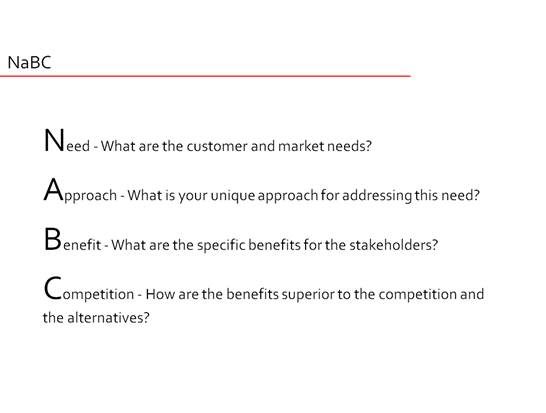When you are to improve a pitch (view a general description of pitching as a method here) or a short presentation of a solution to a problem, it is a good idea to base it on a template, as this will help you prioritise and structure your material. In a situation where you need to convince an audience of the value of the solution you have developed, NABC is a useful tool as it highlights the value for the end users.

Method Plan the pitch with the NABC-model

Instructions
NABC stands for Need, Approach, Benefit and Competition and these are the four elements the students should base their pitch on. NABC may also be used as a process model, read more about this here.
The pitch might begin with a short introduction that catches the audience’s interest. This could for example be a short story, a description of a situation in which the product is used, a user quote or something else. The purpose of the introduction is to capture and hold the audience’s attention.
After the introduction the student’s pitch needs to cover the four elements of NABC, but not necessarily in the same order. In the following you will find a number of questions the students might consider in relation to each of the four elements:
- N: Who needs my product? Do they know their own needs? How do they describe their needs? How do I understand their needs? How big are their needs?
- A: What is my solution based on? What is specific about my solution? In what way does it meet the users’ needs? Why are you the right one to provide the solution?
- B: What concrete advantages does your solution provide? In answering this, the students need to be as concrete and quantitative as possible. Does the solution enable the user to save time or money?
- C: Who are your competitors? Do the users know your competitors? What are the alternatives to your solution (what the user normally does)? Why is your solution better than the alternatives?
It is important that the pitch focuses on the need and value for the users rather than the description of the actual solution.
The pitch ends with the students telling about what results implementing their solution would provide, or describing what needs to be done in order to implement the solution.
Worth Considering
A pitch can last between 3 and 15 minutes, but it is better to provide the students with a short time limit as this forces them to deliver their message in a sharp and precise manner and it also leaves more time for feedback and questions.
The pitch is useful when the final solution needs to be presented to an audience, but it is also useful earlier in the process when the students present their preliminary solutions to each other and receive feedback.
The preparation of a pitch may also be combined with exercising oral presentation techniques or argumentation theory in order to improve the quality of the pitch.
Sources
Carlson, Curtis R. & Wilmot, William W., (2006). Innovation. The Five Disciplines for Creating What Customers Want. New York, Crown Business
